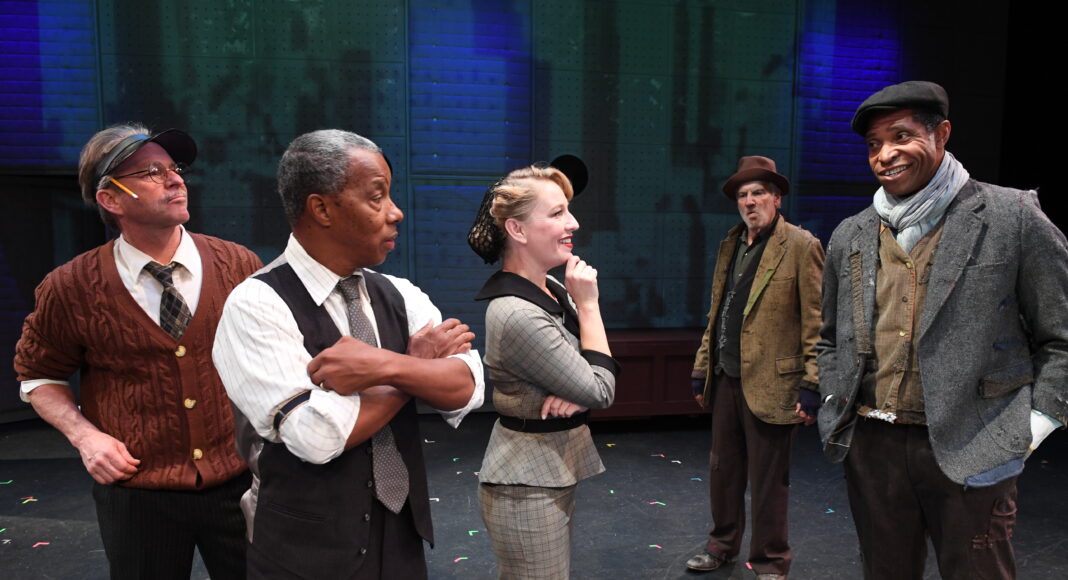With the holiday season upon us, who could forget that classic Frank Capra film where a downtrodden American everyman, overwhelmed by the injustices of the world, contemplates jumping to his death on Christmas Eve, but ultimately finds redemption thanks to the intervention of the people who care about him the most?
What? No, I’m not talking about It’s a Wonderful Life! I’m talking about the other film Capra made with that plot five years earlier, Meet John Doe. For its holiday show, San Jose Stage is presenting a stage version of Capra’s lesser-known gem, adapted and directed by Kenneth Kelleher.
Meet John Doe is all about populist movements, and I hope this excellent production sparks not only a holiday tradition locally, but also some renewed interest in the 1941 film—which, while still respected among cinephiles, has only a fraction of the cultural currency that It’s a Wonderful Life has found now that it’s catapulted into the pantheon of Christmas movies.
Which is strange, because of the two, Meet John Doe is smarter, sharper, funnier and far more ambitious. They’re both even more relevant today than they were in the 1940s (and It’s a Wonderful Life has Jimmy Stewart, I’ll give you that), but I much prefer Meet John Doe’s pointed satire about human empathy triumphing over corporate and political corruption more than I do Wonderful Life’s goofy angel angle.
You can tell that Kelleher does too, because his adaptation follows the film pretty much exactly. The sparse stage decorations, like the “On The Air” and “Stand By” radio station lights, are modeled on those in the movie, and he even projects clips from Capra’s film behind the actors to give a sense of scale and place.
The story follows a fired newspaper columnist (played by Barbara Stanwyck in the movie) who invents a fake character named John Doe for her final editorial, writing that he is so fed up with the evils of the world and man’s inhumanity to man that he plans to jump off City Hall on Christmas Eve. This sends sympathetic readers and nervous politicians in search of John Doe, which leads to the newspaper hiring a down-and-out tramp to pretend he is John Doe, and sets off a remarkable chain of events in which life imitates art that imitates life. It all winds up on the roof of City Hall on Christmas Eve with a moving swell of humanism.
In fact, the only particularly noticeable difference between this stage version and the film is the casting of Black actors in a couple of key roles here—but considering that the play is set in the same era as the movie, it’s an important difference. Certainly making John Doe’s failed-pitcher character a Black man six years before Jackie Robinson entered the major leagues (if we’re to go by the film’s release date) adds a whole new layer of depth to what we can imagine his character has endured on his way to living under bridges.
The lead actor who embodies the “John Doe philosophy” in this production, Aldo Billingslea, is one of a number of knockout performances. Just as the film relies heavily on Gary Cooper’s charm as Doe, so does Billingslea match Cooper’s mix of comic innocence and gravitas here. In two of the story’s key moments, he even surpasses it: first, when the photographers come to get pictures of John Doe for the first time, Billingslea’s facial expressions as he attempts to pose with no idea of what a media star should look like are hilarious. Then, when he is reading a John Doe speech that has been written for him by the columnist, Ann Mitchell (played here by Jennifer Le Blanc), the way he shows the transformation on his face as Doe starts to believe what he is saying is absolutely incredible.
This, I think, is a perfect example of the Stage’s strength as a company. They showcase actors more than stage dressing, and the intimate, close-up setting of the room allows us to fully experience the power of a performance like Billingslea’s. Le Blanc is also fabulous, subtly melting the cynical edge off her newsroom vet as the story progresses, and giving us a window into a character who didn’t even realize the power of her own writing until she’s forced to navigate this misadventure. The rest of the cast is uniformly solid, especially a very funny and warm Donna Fredrico, as both the mayor’s secretary and Ann’s mother, and Norman Gee, who adds some grit to a newspaper editor character that was a fairly typical stick-in-the-mud foil in the film.
A staunch conservative, Capra tended to get overly sentimental and preachy, and there’s some of that in Meet John Doe, for sure. But liberal, sharp-witted screenwriter Robert Riskin (who wrote Meet John Doe, as well as 1936’s Mr. Deeds Goes to Town) was his best collaborator, and Kelleher smartly leans into Riskin’s vibe, picking up the pace and setting a tone that’s more along the lines of another newspaper-film classic, the 1940 screwball comedy His Girl Friday, than Capra’s ultra-earnest delivery.
Like It’s a Wonderful Life on cable, I hope to see Kelleher’s Meet John Doe come around every holiday season.
Meet John Doe runs through Dec. 18 at San Jose Stage, 490 S. First St., San Jose. For tickets, go to thestage.org.



